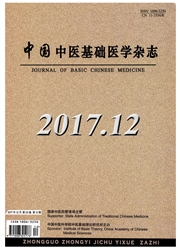

 中文摘要:
中文摘要:
<正>Syndrome differentiation is the character of Chinese medicine(CM).Disease differentiation is the principle of Western medicine(WM).Identifying basic syndromes feature and structure of disease of WM is an important avenue for prevention and treatment of integrated Chinese and Western medicine.The idea here is first to divide all patients suffering from a disease of WM into several groups in the light of the stage of the disease,and secondly to identify basic syndromes feature in a distinct stage,and finally to achieve the purpose of syndrome differentiation.Syndrome differentiation is simply taken as a classifier that classifies patients into distinct classes primarily based on overall observation of their symptoms.Previous clustering methods are unable to cope with the complexity of CM.We therefore show a new multi-dimensional clustering method in the form of general latent structure(GLS) model,which is a suitable statistical learning technique of latent class analysis.In this paper,we learn an optimal GLS model which reflects much better model quality compared with other latent class models from the osteoporosis patient of community women(OPCW) real data including 40-65 year-old women whose bone mineral density(BMD) is less than mean-2.0 standard deviation(M-2.0SD). Further,we illustrate a case analysis of statistical identification of CM syndromes feature and structure of OPCW from qualitative and quantitative contents through the GLS model.Our analysis has discovered natural clusters and structures that correspond well to CM basic syndrome and factors of osteoporosis patients(OP). The GLS model suggests the possibility of establishing objective and quantitative diagnosis standards for syndrome differentiation on OPCW.Hence,for the future it can provide a reference for the similar study from the perspective of a combination of disease differentiation and syndrome differe(?)on.
 英文摘要:
英文摘要:
Syndrome differentiation is the character of Chinese medicine (CM). Disease differentiation is the principle of Western medicine (WM). Identifying basic syndromes feature and structure of disease of WM is an important avenue for prevention and treatment of integrated Chinese and Western medicine. The idea here is first to divide all patients suffering from a disease of WM into several groups in the light of the stage of the disease, and secondly to identify basic syndromes feature in a distinct stage, and finally to achieve the purpose of syndrome differentiation. Syndrome differentiation is simply taken as a classifier that classifies patients into distinct classes primarily based on overall observation of their symptoms. Previous clustering methods are unable to cope with the complexity of CM. We therefore show a new multi-dimensional clustering method in the form of general latent structure (GLS) model, which is a suitable statistical learning technique of latent class analysis. In this paper, we learn an optimal GLS model which reflects much better model quality compared with other latent class models from the osteoporosis patient of community women (OPCW) real data including 40 65 year old women whose bone mineral density (BMD) is less than mean2.0 standard deviation (M 2.0SD). Further, we illustrate a case analysis of statistical identification of CM syndromes feature and structure of OPCW from qualitative and quantitative contents through the GLS model. Our analysis has discovered natural clusters and structures that correspond well to CM basic syndrome and factors of osteoporosis patients (OP). The GLS model suggests the possibility of establishing objective and quantitative diagnosis standards for syndrome differentiation on OPCW. Hence, for the future it can provide a reference for the similar study from the perspective of a combination of disease differentiation and syndrome differentiation.
 同期刊论文项目
同期刊论文项目
 同项目期刊论文
同项目期刊论文
 Variable selection using the optimal ROC curve: An application to a Traditional Chinese Medicine stu
Variable selection using the optimal ROC curve: An application to a Traditional Chinese Medicine stu 期刊信息
期刊信息
